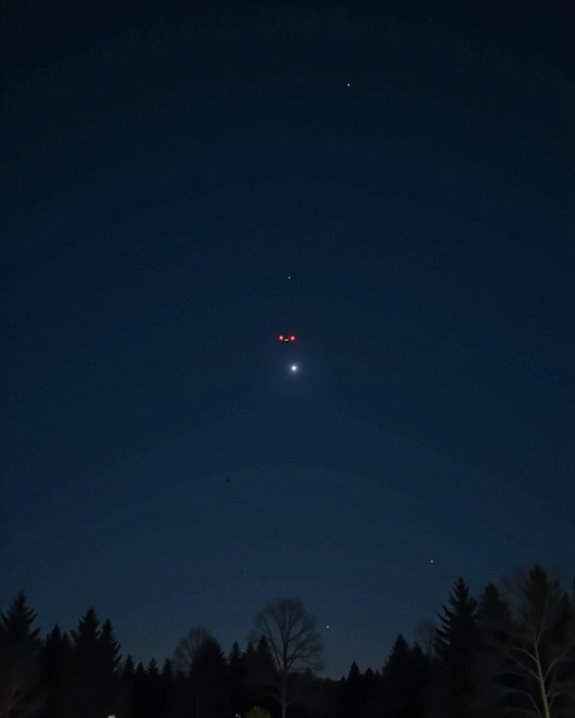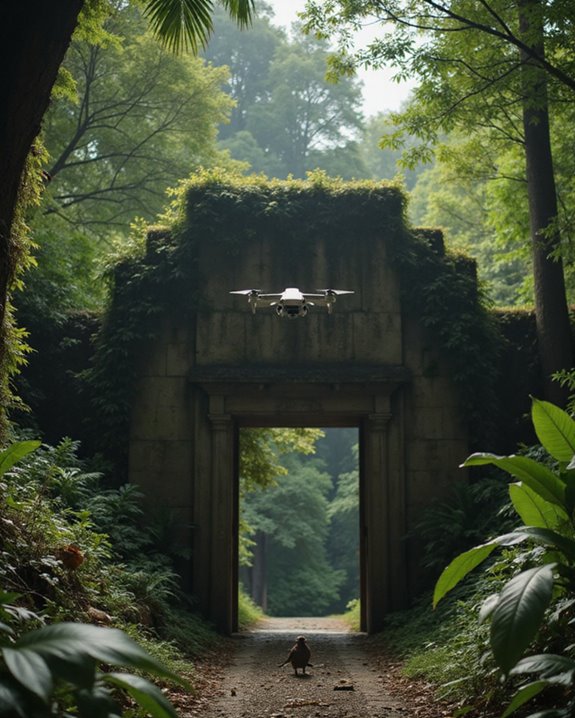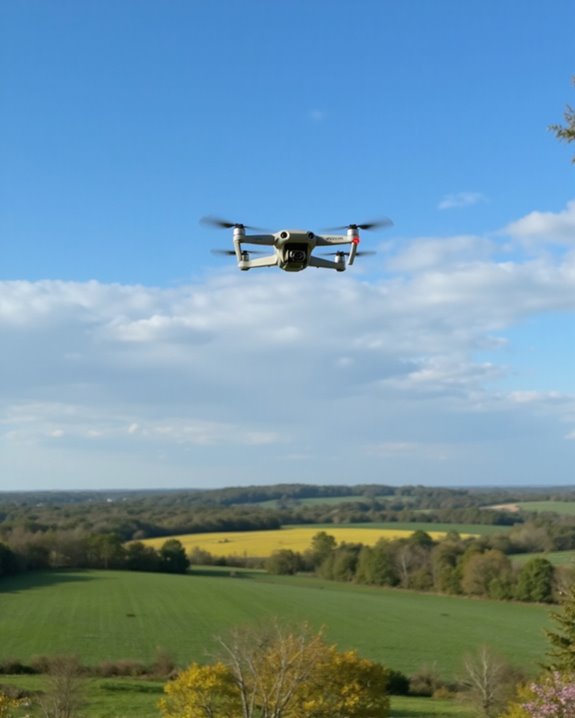Police drones at night reveal themselves through distinctive light patterns—typically flashing red, white, and green navigation lights blinking 40-100 times per minute. Listen for their characteristic buzzing sound, similar to bees but mechanical, which travels farther in nighttime stillness. Watch for telltale flight behaviors like extended hovering (40+ minutes), grid-pattern movements, or focused circling above areas of interest. Bad weather conditions like fog or rain can greatly reduce your ability to spot these aerial observers. The rest of this guide offers even more detection techniques!
Key Takeaways
- Look for distinctive red, white, and green anti-collision lights blinking 40-100 times per minute in the night sky.
- Listen for buzzing or humming sounds similar to bees, which become more noticeable in nighttime quiet.
- Watch for hovering behavior or systematic grid patterns that police drones typically follow during surveillance.
- Identify quadcopter or fixed-wing silhouettes contrasting against dark backgrounds or reflecting light.
- Note blue and red flashing light combinations specifically indicating police surveillance operations.
How to Spot a Police Drone at Night
When darkness falls, identifying police drones becomes greatly more challenging, yet not impossible with the right knowledge and tools. Despite common Drone Myths suggesting they’re completely invisible at night, police drones actually leave several telltale signatures that observant citizens can detect!
The primary Spotting Challenges come from reduced visibility, but thermal imaging devices and night vision goggles can overcome these limitations beautifully. Look for distinct flight patterns – police drones often hover in one area or follow predictable routes while gathering data. Their buzzing noise, though quieter than commercial models, becomes more noticeable in the night’s stillness.
Apps like AirMap can provide real-time information about drone activity nearby, cutting through the confusion. Remember, most police drones must display navigation lights, making them visible as moving points against the night sky. Additionally, many law enforcement drones incorporate AI Night Shot technology to enhance their operational effectiveness in low-light conditions.
Identifying Characteristic Light Patterns and Colors
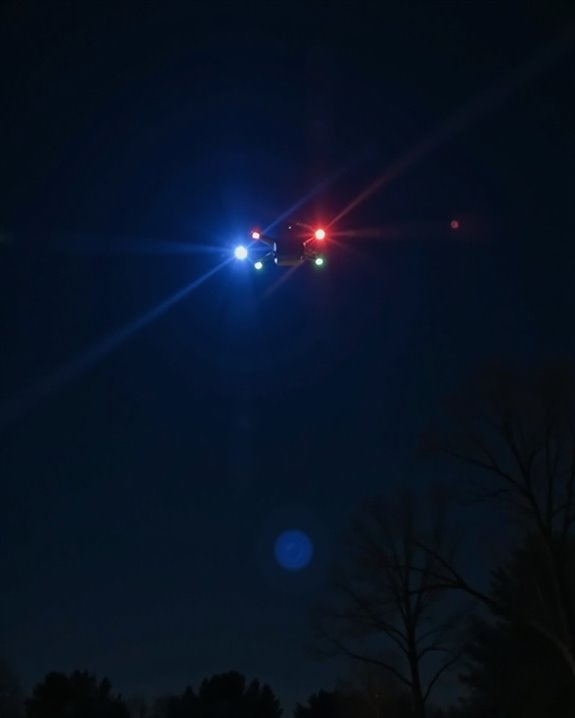
The characteristic light patterns and colors of police drones serve as their most identifiable features in nighttime surveillance operations! Throughout Light History, law enforcement has adopted specific illumination configurations that make their aircraft instantly recognizable. Police drones typically display red, white, and green anti-collision lights that blink at rates between 40-100 flashes per minute.
What makes police drones stand out is their distinctive use of blue and red flashing combinations, a telltale sign you’re being watched from above! Color Science explains why these specific hues were chosen – they maximize visibility at the required 3-mile distance while clearly communicating the drone’s orientation. Red lights indicate the front, green lights mark rear or side positions, and bright white lights serve dual purposes of illumination and meeting FAA visibility requirements. If you spot these multi-colored strobing patterns in unusual configurations, you’re likely observing law enforcement in action! Many police drones employ advanced LED strobe lights that offer multiple flash modes and extended visibility for safe and effective night flying.
Listening for Distinct Propeller Sounds in the Night
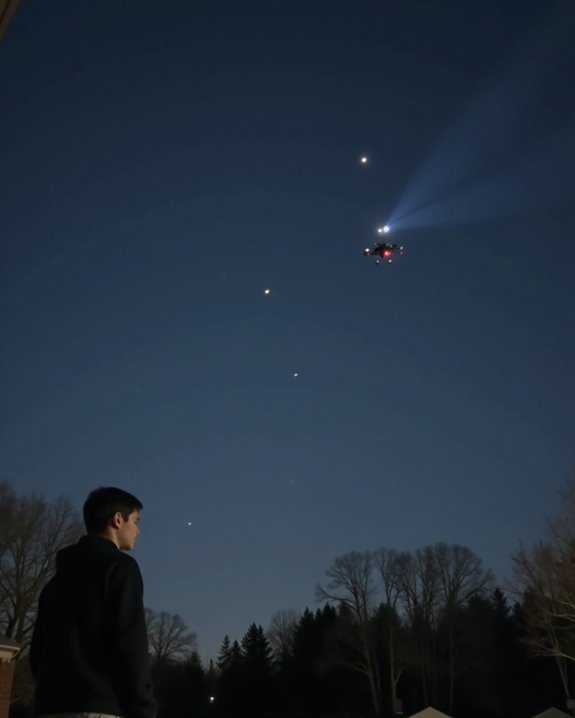
Identifying police drones at night becomes much easier when you tune your ears to their characteristic buzzing sounds! The rapid spinning of propellers creates a distinctive humming noise often compared to angry mosquitos or electric razors. This acoustic signature becomes particularly noticeable in the quiet nighttime environment.
Acoustic Training can greatly improve your ability to detect these mechanical visitors. By familiarizing yourself with typical drone sounds, you’ll develop valuable Noise Profiling skills that help distinguish them from other environmental noises. When ambient noise decreases after dark, those bee-like buzzes become your best detection tool!
For best results, find a quiet spot away from background noise. Remember, the louder the buzz, the closer the drone! While police models are designed to be stealthier than consumer drones, their propellers still can’t completely escape physics – they must make some sound to stay aloft. Advanced drones often use rubber-tipped blades to reduce noise and vibration, enhancing stealth capabilities.
Recognizing Common Night Surveillance Flight Behaviors
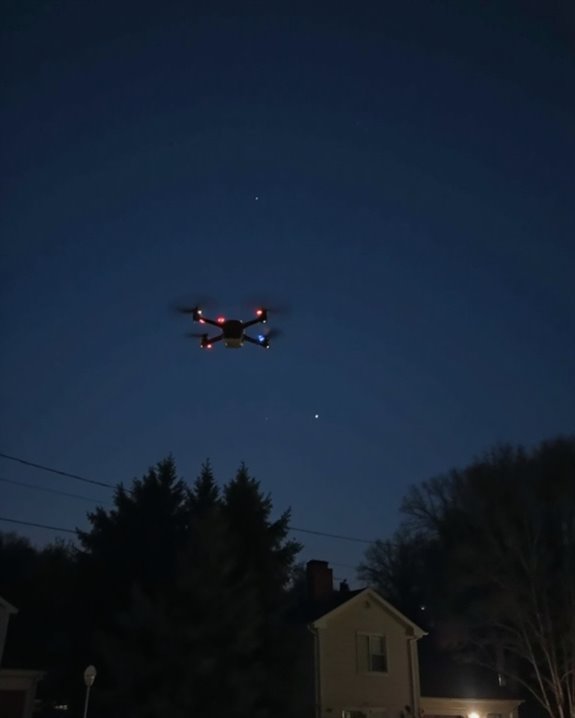
Have you ever noticed a drone that seems strangely deliberate in its movements, unlike the erratic flight patterns of hobbyist flyers? Police drones follow specific flight behaviors that can give away their surveillance purpose!
Law enforcement UAVs typically conduct systematic Grid Patrols, methodically covering areas in pre-programmed patterns that civilian drones rarely follow. Watch for devices that maintain position above a single location – the Hover Duration of police drones can exceed 40 minutes, far longer than typical consumer models. This extended hovering allows officers to gather detailed information without interruption.
Other telltale signs include abrupt direction changes, focused circling around “hotspots,” and smooth target-tracking movements. At night, these drones move more slowly and steadily to capture clear thermal imaging data, making their deliberate flight patterns even more noticeable against the dark sky.
Using Technology to Detect Drone Presence
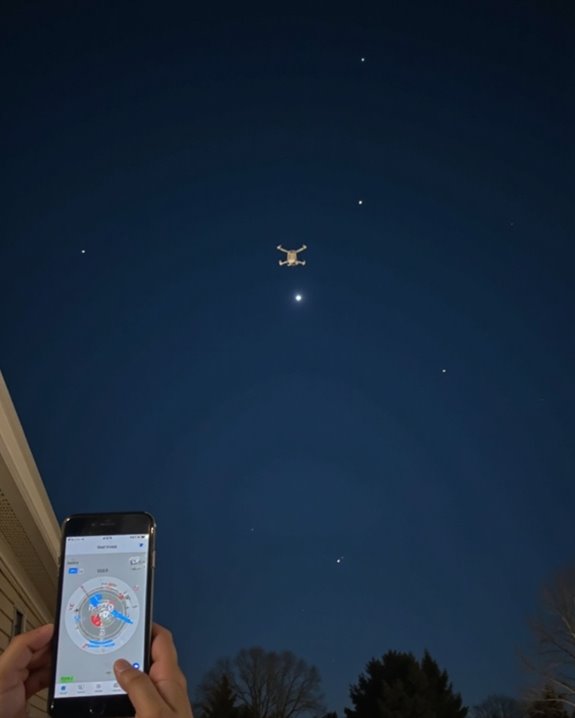
Leveraging modern technology effectively turns the tables on surveillance drones, giving citizens powerful tools to detect when they’re being watched! With the rising availability of detection systems, anyone can become aware of nearby aerial surveillance.
RF Detection systems monitor the communication signals between drones and their operators, revealing their presence even when invisible to the naked eye. Popular platforms like AirMap display real-time drone activity in your vicinity, while specialized mobile apps harness the power of Data Analytics to identify distinctive drone patterns. For tech enthusiasts, acoustic sensors can pick up the unique buzzing sounds that most police drones make – think of them as unwanted mosquitoes that can’t hide from your digital swatter! These smart monitoring systems combine multiple data sources, creating a complete picture of aerial surveillance in your area.
Differentiating Police Drones From Civilian Models
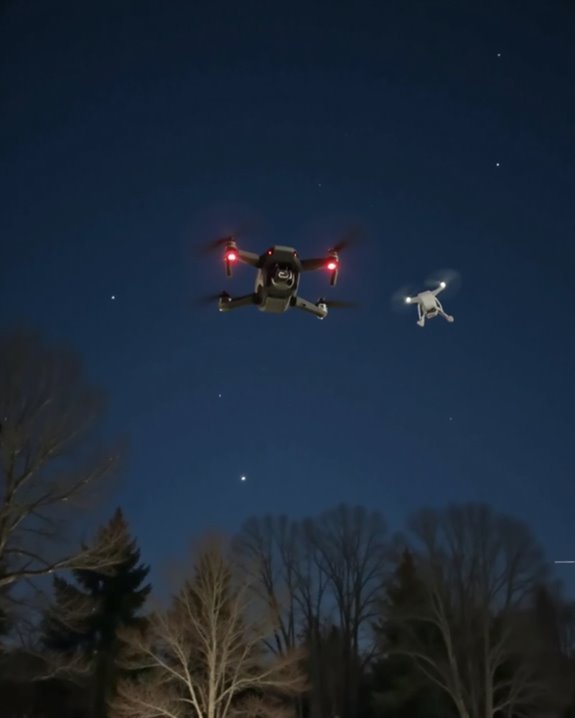
While civilian drones might blend together in appearance, police surveillance drones possess distinct characteristics that set them apart from their hobby counterparts! These law enforcement models typically feature a more rugged construction and greater Payload Capacity, allowing them to carry specialized equipment like thermal cameras and spotlights. You’ll notice they often operate at consistent altitudes and follow methodical flight patterns when conducting surveillance.
Police drones must adhere to stricter Regulatory Standards, but ironically, they’re permitted to fly in restricted zones where your backyard flyer would get grounded immediately. Their size tends to be larger, and that distinctive humming noise? That’s all those sophisticated sensors hard at work! At night, they may display unique lighting configurations or maintain prolonged hovering capabilities that your neighbor’s Christmas gift simply can’t match.
Understanding Thermal and Infrared Imaging Signatures
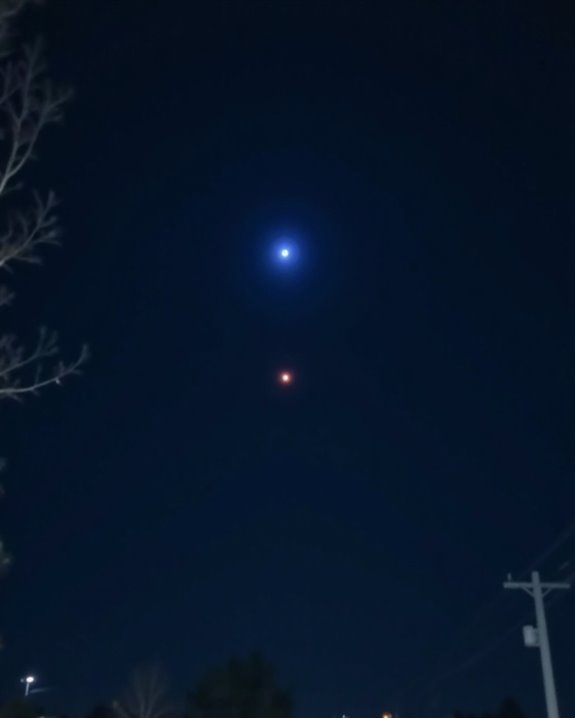
Police drones equipped with thermal imaging technology represent one of law enforcement’s most powerful surveillance tools! These sophisticated devices detect heat signatures from people, vehicles, and even buildings, making them incredibly effective during nighttime operations. Unlike traditional cameras that rely on visible light, thermal imaging captures radiation emitted by all objects above absolute zero.
While this technology was initially developed for Medical Diagnostics, it’s now essential for law enforcement surveillance! The thermal cameras can spot a hidden suspect by their body heat alone, even through smoke, fog, or dense vegetation. Law enforcement agencies also utilize these systems for Environmental Monitoring purposes, tracking heat signatures across large areas without requiring visual line of sight. The unique thermal signature of drone propulsion systems makes them identifiable against the night sky’s cooler background.
Legal Rights When Spotting Police Drones Near Your Property
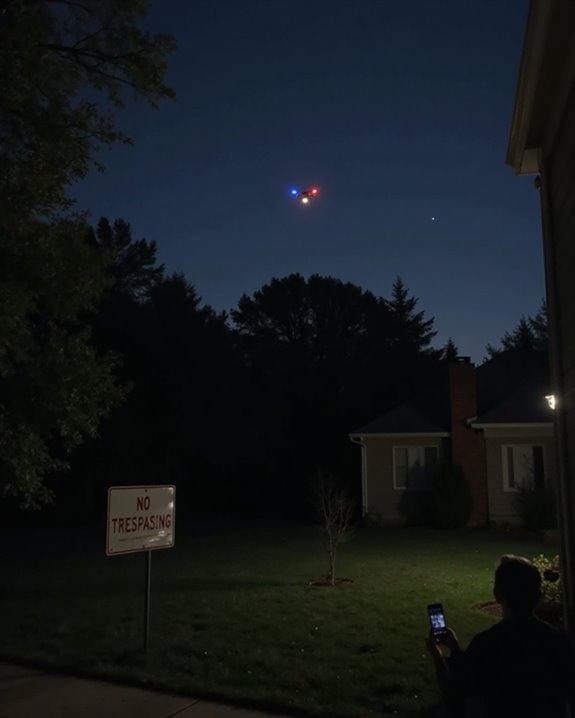
Knowing the thermal signature of police drones is valuable, but understanding your legal rights when these devices appear near your home is equally important for protecting your privacy! The Fourth Amendment generally requires police to obtain a warrant before conducting drone surveillance over your property. Without one, their evidence might be challengeable in court.
Many states have enacted specific laws limiting police drone operations, creating a patchwork of PrivacyAdvocacy protections across the country. In public spaces, however, your privacy expectations are reduced, and warrant requirements may not apply.
When facing potential surveillance, document the drone’s presence and consider consulting an attorney. The LegalChallenges surrounding drone surveillance are still evolving, as courts continue balancing law enforcement needs against citizens’ reasonable expectations of privacy in their homes and yards!
Weather Conditions That Affect Drone Visibility at Night
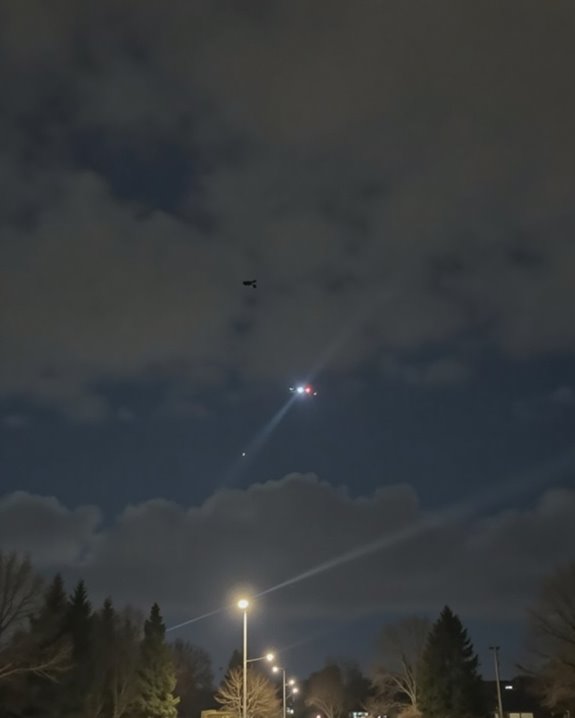
How drastically can weather conditions impact your ability to spot police drones after dark? Quite greatly! Fog Effects create perhaps the most challenging conditions, as this thick blanket of moisture particles severely reduces visibility ranges and can completely obscure a drone’s navigation lights, even from relatively short distances.
Rain Impacts visibility in multiple ways, creating both visual and auditory challenges. During rainfall, water droplets not only distort your line of sight but also create ambient noise that can mask the distinctive humming sound of drone propellers. Additionally, high humidity conditions often lead to mist formation, further complicating detection efforts. Cloud cover poses another obstacle by limiting the contrast between the night sky and the drone’s silhouette, while wind affects both sound travel and the drone’s flight stability, potentially making it harder to track.
Strategic Locations Where Police Drones Typically Operate
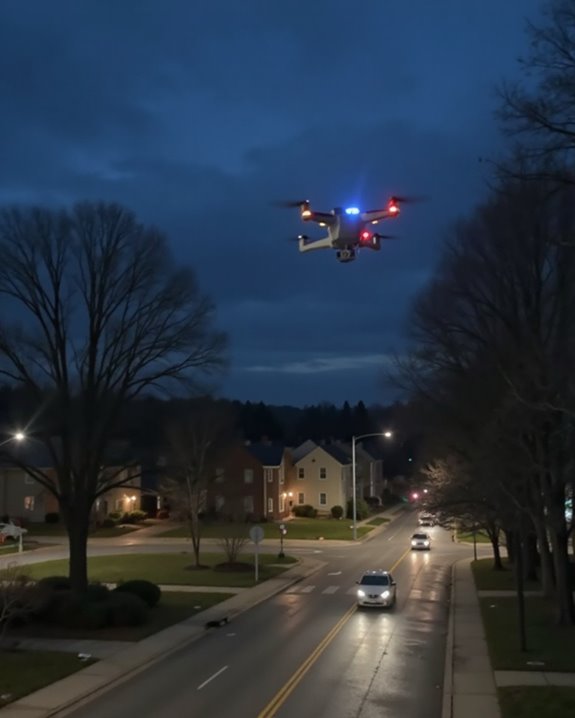
The strategic deployment of police drones follows distinct patterns that, once understood, can help you identify their likely operational zones.
Police drones frequently hover near public gatherings, high-crime neighborhoods, and critical infrastructure sites where traditional surveillance is challenging. You’ll often spot them monitoring protest activities, sporting events, and festivals where crowd management is essential! Border Patrol units regularly deploy drones along boundary areas to track unauthorized crossings without risking officer safety. After storms or earthquakes, Disaster Zones become drone hotspots as teams assess damage and coordinate rescue efforts. At night, these aerial units are particularly active around transportation hubs, coastal waters, and areas with ongoing investigations. Remember, urban centers see different drone patterns than rural regions, with city operations focusing on crime deterrence while countryside deployments typically handle search missions and large-territory monitoring.
Frequently Asked Questions
Can Police Drones See Through Walls or Windows at Night?
Like fish hitting an aquarium wall, police drones cannot see through solid barriers. Their thermal imaging and infrared capabilities can detect heat signatures but only on surfaces, not through walls or windows, regardless of time.
How High Do Police Drones Typically Fly During Surveillance Operations?
Police drones typically operate at flight altitudes between 143-200 feet during surveillance, though they may reach 11,000+ feet for special operations. Regulatory heights limit them to 400 feet under standard FAA guidelines for safe operations.
What Should I Do if a Drone Follows Me?
If someone is being followed by a drone, they should avoid evasive tactics which could be illegal. Instead, documenting the incident and reporting it to local authorities is the recommended course of action.
Do Police Drones Record Audio Along With Video Footage?
Police drones often have audio recording capabilities alongside video. Usage is governed by Recording Laws that vary by jurisdiction. Audio Ethics considerations include privacy concerns, as recording conversations without consent may violate regulations in many areas.
How Can I Tell if a Drone Is Recording Me Specifically?
Individuals cannot definitively determine if a drone is recording them specifically. Recording indicators may include hovering patterns above one location and camera positioning. Privacy detection methods remain limited due to drones’ surveillance capabilities from a distance.

